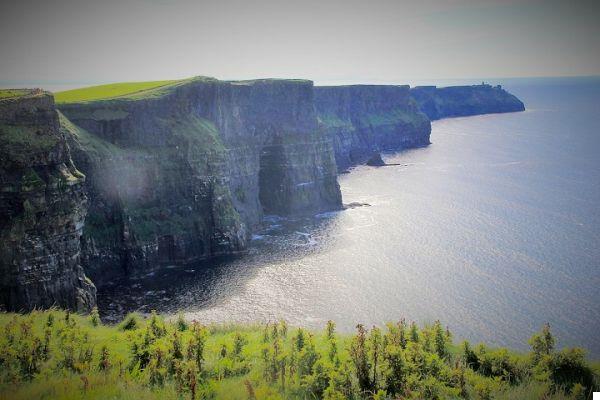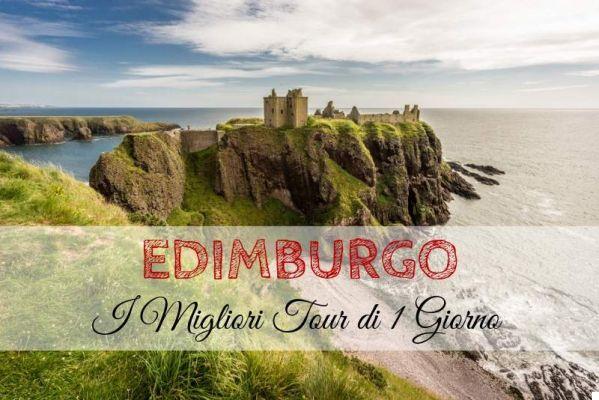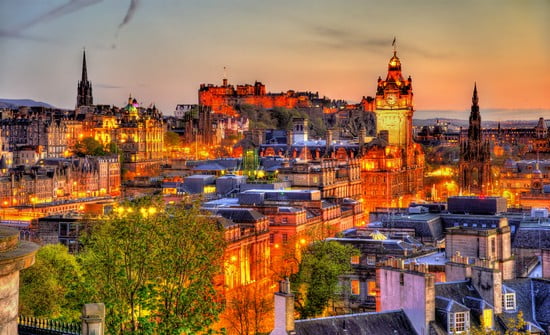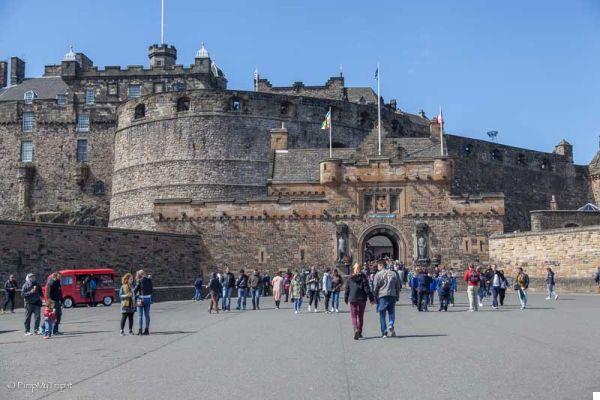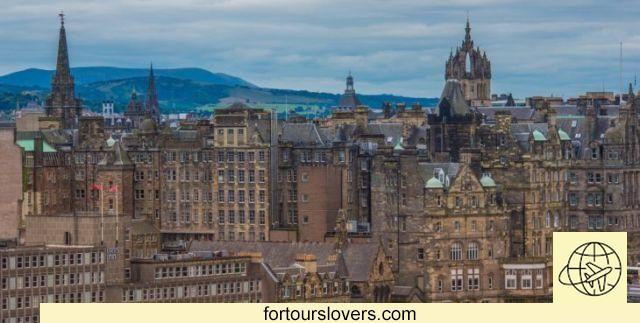
Edinburgh
8 things to do and see in Edinburgh and 4 not to doUntil not many years ago Edinburgh it was considered at most as prelude to the Highland tour, then things began to take a different turn with the autonomy granted by the British government to Scotland in 1997 following a referendum. The Scottish parliament and government, albeit with limited sovereignty, have been able to work on one new tourist programming which accompanied the development of the city in the XNUMXst century. Cultural festivals, boutiques, restaurants and pubs have contributed in a decisive way to rejuvenate the image of the city, making it one of the most popular tourist destinations in Europe, especially by young people. On the other hand, however, it was update the artistic and literary heritage already present. Great impulse, in this sense, came from theUnesco than before, in 1995, recognized the two distinct areas of the city center (Old Town and New Town) "World Heritage Site" and then, in 2004, has provided the second, area, recognition which "City of literature". Edinburgh, in fact, gave birth to several internationally renowned writers: from Walter Scott who, with his novels, was the first to feed the trend of literary tourism around the city, ad Arthur Conan Doyle, father of Scherlock Holmes. Without forgetting, finally, Irvine Welsh, the author of Trainspotting, a corrosive fresco of the city at the turn of the 80s and 90s, made famous by the homonymous film by the English director Danny Boyle. In short, culture and entertainment are the "assets" on which Edinburgh has climbed the slope in the last 20 years. For the list of recommended hotels click here. Now let's take a closer look at the things to do and see in the city. Official site of the city: www.edinburgh.gov.uk
1 Edinburgh Castle
At the beginning we mentioned the very close relationship between Edinburgh and literature. This obviously applies to indigenous writers, but it also applies to those who, despite not having been born there, have drawn great inspiration from the city for their novels. It is the case of JKRowling, to which the view of the majestic "Edinburgh Castle" has given many notes for the Harry Potter draft. Not only. We also mentioned the importance of festivals as a city tourist attraction. One of the most important, the Royal Edinburgh Military Tattoo, takes place on the esplanade (Explanade) of the Castle that dominates the medieval part (Old Town) of Edinburgh. It is an international parade in which military bands from over 40 countries around the world participate and, a very strategic choice, takes place simultaneously with theEdinburgh International Festival, a theatrical review that takes up almost the entire month of August. A few hints, yet sufficient to understand the historical and symbolic importance of the Royal Palace of Edinburgh. Inside, don't miss it "Scottish National War Museum", the National War Museum of Scotland, as well as a must-see is the "Stone of Destiny" the ancient throne on which Scottish kings were crowned. Finally a curiosity: if at 13.00 you are near the castle, cover your ears for the cannon shot, nicely renamed "One o 'clock gun" (o "Lunch time bang"), which gives the time to the people of Edinburgh every day except Sunday. For more information on visits, timetables and events taking place inside the Castle visit the Official site: www.edinburghcastle.gov.uk
2 Palace of Holyroodhouse
Holyroodhouse Palace is one of the official residences of Queen Elizabeth II of England that passes here, in what was there historic home of Maria Stuarda (1542-1587), his days in Scotland. And it is precisely the tragic story of the latter that is used to explain the importance of the location. In fact, several historically relevant episodes took place in the walls of the palace, including the killing of David Rizzio, highly cultivated factotum of the then Queen of Scotland Maria Stuart (Stuarda is the Italian distortion of the surname). A retaliation wanted by the second husband of the latter, Lord Darnley who, in cahoots with the city aristocracy, decided to punish his wife for the excessive liberality of a lifestyle that was too focused on the study of literature and singing. In reality, there was the detonator to the story'tightening of relations between Catholics and Protestants. A conflict that also affected the monarchy and which was finally resolved with the killing of Maria Stuarda at the hands of her cousin Elizabeth I. Briefly said about the history, the Castle also deserves an original synthesis of French and Scottish traditions from an architectural point of view. To find out more visit the page Edinburgh | Palace of Holyroodhouse (Italian translation also available) from place www.royalcollection.org.uk.
3 Arthur's Seat
Holyrood Palace is located inside the park of the same name (Holyrood Park) which also includes three small hills of volcanic origin. The most famous of the three is Arthur's Seat which, with its 250 meters high, offers an amazing view, far beyond the magnificent sky line of Edinburgh. For this reason, Arthur's Seat is a daily destination for many tourists. There are several paths to get to the top, none of which present great difficulties. The only precaution issuitable clothing, especially shoes that must have good grip so as not to slip while walking. The presence of such a great level of naturalistic scenery, moreover in the center, is one of the most fascinating reasons of Edinburgh. If we add to this data the stories that happened and the discoveries made in these same places, the suggestion increases even more. We refer, among many others, to the discovery, in 1836, of 17 small coffins at the hands of a group of kids intent on playing right on the hill of Arthur's Seat. After some conjectures about witchcraft and magical rituals, the truth emerged: someone had built those miniature coffins to offer, at least symbolically, a worthy burial to the unfortunates killed by William Burke and William Hare, criminal couple who a few years before the discovery in question had committed a series of murders in the city to resell the bodies to a well-known anatomist of the time, such dr. Robert Knox. The coffins are now visible in the National Museum of Scotland and they are only one of the many attractions of this building, which was enlarged and renovated in the late 90s of the last century (see next paragraph).
4 National Museum of Scotland
even the National Museum testifies what was said at the beginning about the "rebirth" of Edinburgh. A rebirth due to one new tourist programming capable of multiplying the leisure opportunities available to tourists and, at the same time, revalue the enormous artistic and cultural heritage inherited from the past. Not surprisingly, the National Museum of Scotland, inaugurated in 1998, has incorporated the Royal Museum from the Victorian era. Almost all the works of the "old" museum are now housed in the "Grand Gallery", one of the 7 floors that make up the structure. The rest of the museum, however, reviews the entire history of Scotland: from its geological origins to the end of the last millennium. From "Animal World", a wing of the museum where dozens of extinct prehistoric animal skeletons are exhibited, to the history of Dolly sheep, the first mammal to be successfully cloned from an adult cell at the Roslin Institute just 10 kilometers from Edinburgh. It's not over because between sculptures, collections e short films there is so much more to see about the most significant moments of Scottish life. For more information on exhibitions and opening hours visit: www.nms.ac.uk/national-museum-of-scotland. Admission is free.
5 St. Giles Cathedral
The Cathedral of Sant'Egidio is unmissable stop for anyone visiting Edinburgh for the first time. What makes it so, more than the architecture and decorations inside, is the history of the building itself, cradle of Scottish Presbyterianism founded by the preacher John Knox (1513 - 1572). The latter, a pupil of Calvino, introduced this particular form of Protestantism which, unlike Catholicism and Anglicanism, is distinguished by the rejection of the hierarchical organization of the clergy. This historical detail clarifies the misuse of the term "cathedral", since this church (also known by the topos of "High Kirk of Edinburgh ") is not a bishopric (except for two parentheses in the XNUMXth century). To see, inside, "Thistel Chapel", the Chapel of the Scottish Order of the Thistle. This is the second British order of chivalry, after that of the "Garter". The presence in the emblem of the national flower (the thistle) clearly suggests that the majority of the members must be Scottish, despite the fact that it is open to external personalities. Finally a curiosity. Near the western door of the church there is a heart-shaped pebble mosaic. The mosaic is a reference to the novel "Heart of Midlothian", in which the writer Walter Scott tells of the old town custom of spitting towards the door of a prison (which stood where the mosaic now stands) as a form of protest for the executions that took place inside. Too bad, however, that later "Heart of Midlothian" also became the name of one of the two Edinburgh football teams. As a result of this circumstance, the fans ofHibernian, the other city team, have seen fit to keep alive the habit of spitting towards the mosaic, this time as teasing against football rivals. For more information about the history, opening hours and activities of the church visit the Official site: www.stgilescathedral.org.uk
6 Old Town
The places described so far are all in the old part of the city, that one "Old Town" which develops around the "Royal Mile", the road from Edinburgh Castle to Holyrood Palace (so called because it is 1,8 km long, standard measure of the mile). Old Town, however, is also worth a visit for its medieval history, in particular for the configuration of the alleys and streets that compose it. A'sui generis town planning due to the reluctance of the Edinburgh people to build outside the city walls. Hence the prevailing height development of the houses, the first historical example of residential skyscrapers. In the middle, between one building and another, a maze of alleys and underpasses in which today there are boutiques, pubs, restaurants and shops but where once heinous crimes also took place, such as serial killings by William Burke and William Hare to which we have mentioned in describing Arthur's Seat. Speaking of undergrounds, the guided tour (approx. 1 hour) of the alleys that unfold under the Mary King's Close. It is an intricate labyrinth of underpasses where a diverse and desperate humanity lived in the XNUMXth century. To learn more, visit the Official site: www.realmarykingsclose.com.
7 Scottish National Portrait Gallery
To deepen the Scottish history there is not only the National Museum. Also the Scottish National Portrait Gallery worth a visit. Inside, a real one picture gallery of national heroes or, to put it in English, the “Who's Who” of homeland history. William Wallace, Robert the Bruce, Sean Connery, Irvine Welsh e Sir Alex Ferguson, are just some of the Scottish personalities present in this beautiful neo-gothic palace reopened to the public in 2011 after a long season of renovation and restoration. Among other things, the Scottish National Portrait Gallery it is just one of the Scottish National Galleries in the city. Those wishing to further expand the cultural tour of Edinburgh will therefore do well to visit the others as well (to learn more: www.nationalgalleries.org). The gallery is located at Civic 1 of Queen St. not far from Princess Street, main artery of the New Town of Edinburgh. Admission is free.
8 Princess Street Gardens
You remember it opening scene of the movie "Trainspotting" with young Mark Renton (actor Ewan McGregor) on the run from the police? That scene was shot in Princess Street, the main artery of the “New Town”, one of the two large areas (the other being the Old Town) into which Edinburgh is divided. Princess Street, as well as being the shopping street citizen, is famous for its gardens where tourists and residents spend part of their days, especially during the summer. It is here that in August it is possible to attend the "Fireworks Concert", a great pyromusical show that closes the annual edition ofEdinburgh International Festival; and it is always here that the characteristic is set up in December "Christmas Market" which, together with the ice rink, enlivens the winter days of the Scottish capital. Not to be missed!
1 Avoid the round of beer or whiskey (unless ...)
As we have already seen in Dublin, also in Edinburgh (but in general throughout the United Kingdom) it is a lot unseemly to withdraw from your drinking round. As long as the company isn't too large, in which case generosity risks costing a fortune. The advice, therefore, is of accompany in small groups. Conversely, don't be too social in the pub. In fact, when the tour company is too large, the risk that is run, as well as economic, is not to hold up large amount of alcohol to which, however, the locals are traditionally more accustomed.
2 Do not drive around the city
Driving in central Edinburgh is quite complicated, which is why getting around the city by car is absolutely inadvisable. Public transport (trams and buses) are so efficient that the Edinburghers themselves prefer them to the car. So do the same.
3 Don't praise Glasgow
Il parochialism it is a characteristic of the Scots. We saw it with the soccer teams (Hibernian vs. Heart of Midlothian) but it also applies to cities. Indeed, perhaps it is even more valid with cities than in sports. Obviously, nine times out of ten it is goliardia, simple teasing, but we must put in mind that someone praises Glasgow just don't go down. In uncertainty, therefore, better avoid comparisons between the two main Scottish cities.
4 Don't call the Scots English
May it never be! The relationship with England has always been a bare nerve. It is no coincidence that one of the most common idioms - here too with different nuances from the goliardic to the terribly serious - reads: "Scottish Not British".





